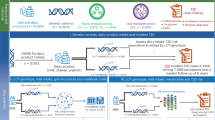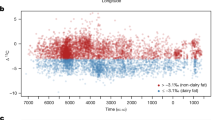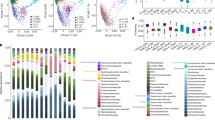Abstract
Background
Lactase persistence—the ability to digest lactose through adulthood—is closely related to evolutionary adaptations and has affected many populations since the beginning of cattle breeding. Nevertheless, the contrast initial phenotype, lactase non-persistence or adult lactase deficiency, is still observed in large numbers of people worldwide.
Methods
We performed a multiethnic genetic study of lactase deficiency on 24,439 people, the largest in Russia to date. The percent of each population group was estimated according to the local ancestry inference results. Additionally, we calculated frequencies of rs4988235 GG genotype in Russian regions using the information of current location and birthplace data from the client’s questionnaire.
Results
The attained results show that among all studied population groups, the frequency of GG genotype in rs4988235 is higher than the average in the European populations. In particular, the prevalence of lactase deficiency genotype in the East Slavs group was 42.8% (95% CI: 42.1–43.4%). We also investigated the regional prevalence of lactase deficiency based on the current place of residence.
Conclusions
Our study emphasizes the significance of genetic testing for diagnostics, i.e., specifically for lactose intolerance parameter, as well as the scale of the problem of lactase deficiency in Russia which needs to be addressed by the healthcare and food sectors.
This is a preview of subscription content, access via your institution
Access options
Subscribe to this journal
Receive 12 print issues and online access
$259.00 per year
only $21.58 per issue
Buy this article
- Purchase on Springer Link
- Instant access to full article PDF
Prices may be subject to local taxes which are calculated during checkout


Similar content being viewed by others
Data availability
For the Genotek dataset, the user agreement (available at https://www.genotek.ru) states that disclosure of individual-level genetic information and/or self-reported information to third parties for research purposes will not occur without explicit consent, and the consent was not obtained from the individuals. Due to the user agreement, the individual level cannot be made directly available, and the dataset could pose a threat to confidentiality. Data have to be accessed indirectly via Genotek Ltd, https://www.genotek.ru/. Data requests should be sent to Genotek Ltd at info@genotek.ru.
References
Suri S, Kumar V, Prasad R, Tanwar B, Goyal A, Kaur S, et al. Considerations for development of lactose-free food. J Nutr Intermed Metab. 2019;15:27–34.
Silanikove N, Leitner G, Merin U. The Interrelationships between lactose intolerance and the modern dairy industry: global perspectives in evolutional and historical backgrounds. Nutrients. 2015;7:7312–31.
Hassan A, Amjad I. Nutritional evaluation of yoghurt prepared by different starter cultures and their physiochemical analysis during storage. Afr J Biotechnol. 2010;9:2913–7.
Skovbjerg H, Norén O, Sjöström H, Danielsen EM, Enevoldsen BS. Further characterization of intestinal lactase/phlorizin hydrolase. Biochim Biophys Acta. 1982;707:89–97.
Leseva MN, Grand RJ, Klett H, Boerries M, Busch H, Binder AM, et al. Differences in DNA methylation and functional expression in lactase persistent and non-persistent individuals. Sci Rep. 2018;8:5649.
Swallow DM, Troelsen JT. Escape from epigenetic silencing of lactase expression is triggered by a single-nucleotide change. Nat Struct Mol Biol. 2016;23:505–7.
Storhaug CL, Fosse SK, Fadnes LT. Country, regional, and global estimates for lactose malabsorption in adults: a systematic review and meta-analysis. Lancet Gastroenterol Hepatol. 2017;2:738–46.
Khabarova Y, Tornianen S, Tuomisto S, Järvelä I, Karhunen P, Isokoski M, et al. Lactase non-persistent genotype influences milk consumption and gastrointestinal symptoms in Northern Russians. BMC Gastroenterol. 2011;11:124.
Fassio F, Facioni M, Guagnini F. Lactose maldigestion, malabsorption, and intolerance: a comprehensive review with a focus on current management and future perspectives. Nutrients. 2018;10:1599.
Deng Y, Misselwitz B, Dai N, Fox M. Lactose intolerance in adults: biological mechanism and dietary management. Nutrients. 2015;7:8020–35.
Ségurel L, Bon C. On the evolution of lactase persistence in humans. Annu Rev Genomics Hum Genet. 2017;18:297–319.
Itan Y, Powell A, Beaumont MA, Burger J, Thomas MG. The origins of lactase persistence in Europe. PLoS Comput. Biol. 2009;5:e1000491.
Gerbault P. The onset of lactase persistence in Europe. Hum Heredity. 2013;76:154–61.
Anguita-Ruiz A, Aguilera CM, Gil Á. Genetics of lactose intolerance: an updated review and online interactive world maps of phenotype and genotype frequencies. Nutrients. 2020;12:2689.
Burger J, Link V, Blöcher J, Schulz A, Wegmann D. Low prevalence of lactase persistence in bronze Age Europe indicates ongoing strong selection over the last 3,000 years. Curr Biol. 2020;30:4307–4315.e13.
Agostoni C, Bresson J-L, Fairweather-Tait S, Flynn A, Golly I, Korhonen H, et al. Scientific Opinion on lactose thresholds in lactose intolerance and galactosaemia. EFSA J. 2010;8:1777.
Shaukat A. Systematic review: effective management strategies for lactose intolerance. Ann Intern Med. 2010;152:797.
Forsgård RA. Lactose digestion in humans: intestinal lactase appears to be constitutive whereas the colonic microbiome is adaptable. Am J Clin Nutr. 2019;110:273–9.
Swagerty DL, Walling A, Klein RM. Lactose intolerance. Am Fam Phys. 2002;65:1845–51.
Binder HJ. Role of colonic short-chain fatty acid transport in diarrhea. Annu Rev Physiol. 2010;72:297–313.
Szilagyi A, Ishayek N. Lactose intolerance, dairy avoidance, and treatment options. Nutrients. 2018;10:1994.
MacDonald HB. Dairy nutrition: What we knew then to what we know now. Int Dairy J. 2008;18:774–7.
Muehlhoff E. Milk and dairy products in human nutrition. Food and Agriculture Organization of the United Nations (FAO) (2013).
Misselwitz B, Pohl D, Frühauf H, Fried M, Vavricka SR, Fox M. Lactose malabsorption and intolerance: pathogenesis, diagnosis and treatment. United Eur Gastroenterol J. 2013;1:151–9.
Hodges J, Cao S, Cladis D, Weaver C. Lactose intolerance and bone health: the challenge of ensuring adequate calcium intake. Nutrients. 2019;11:718.
Food and Agriculture Organization of the United Nations & World Health Organization. Sustainable healthy diets: Guiding principles. (2019).
U.S. Department of Agriculture & U.S. Department of Health and Human Service. Dietary Guidelines for Americans, 2020-5. (2020).
Ministry of Food, Agriculture and Fisheries. The Official Dietary Guidelines - Good for Health and Climate. (The Danish Veterinary and Food Administration, 2021).
Hu F, Cheung L, Otis B, Oliveira N & Musicus A. The Nutrition Source–Healthy Living Guide 2020/2021: A Digest on Healthy Eating and Healthy Living. (Department of Nutrition at the Harvard T.H. Chan School of Public Health, 2021).
Public Health England, Welsh Government, Food Standards Scotland, & Food Standards Agency in Northern Ireland. The Eatwell Guide: Helping You Eat a Healthy, Balanced Diet.(2018).
Vesa TH, Marteau P, Korpela R. Lactose intolerance. J Am Coll Nutr. 2000;19:165S–175S.
Durbin R. Efficient haplotype matching and storage using the positional Burrows-Wheeler transform (PBWT). Bioinformatics. 2014;30:1266–72.
International Organization for Migration (IOM). World Migration Report. (2020).
Segurel L, Guarino-Vignon P, Marchi N, Lafosse S, Laurent R, Bon C, et al. Why and when was lactase persistence selected for? Insights from Central Asian herders and ancient DNA. PLOS Biol. 2020;18:e3000742.
Gerbault P, Liebert A, Itan Y, Powell A, Currat M, Burger J, et al. Evolution of lactase persistence: an example of human niche construction. Philos Trans R Soc B: Biol Sci. 2011;366:863–77.
Allentoft ME, Sikora M, Sjögren KG, Rasmussen S, Rasmussen M, Stenderup J, et al. Population genomics of bronze age Eurasia. Nature. 2015;522:167–72.
Wilkin S, Ventresca Miller A, Fernandes R, Spengler R, Taylor WT, Brown DR, et al. Dairying enabled Early Bronze Age Yamnaya steppe expansions. Nature. 2021;598:629–33.
Beja-Pereira A, Luikart G, England PR, Bradley DG, Jann OC, Bertorelle G, et al. Gene-culture coevolution between cattle milk protein genes and human lactase genes. Nat Genet. 2003;35:311–3.
Yunusbayev B, Metspalu M, Järve M, Kutuev I, Rootsi S, Metspalu E, et al. The Caucasus as an asymmetric semipermeable barrier to ancient human migrations. Mol Biol Evolut. 2012;29:1891.
Jeong C, Balanovsky O, Lukianova E, Kahbatkyzy N, Flegontov P, Zaporozhchenko V, et al. The genetic history of admixture across inner Eurasia. Nat Ecol Evolut. 2019;3:966–76.
Pugach I, Matveev R, Spitsyn V, Makarov S, Novgorodov I, Osakovsky V, et al. The complex admixture history and recent Southern origins of Siberian populations. Mol Biol Evolut. 2016;33:1777–95.
Fedorova SA, Reidla M, Metspalu E, Rootsi S, Tambets K, Trofimova N, et al. Autosomal and uniparental portraits of the native populations of Sakha (Yakutia): implications for the peopling of Northeast Eurasia. BMC Evolut Biol. 2013;13:127.
Ushnitskiy VV. The Problem of the Sakha People’s Ethnogenesis: a New Approach. Journal of Siberian Federal University. Humanit Soc Sci. 2016:1822–40 https://doi.org/10.17516/1997-1370-2016-9-8-1822-1840.
Crubézy E, Amory S, Keyser C, Boukaze C, Bodner M, Gibert M, et al. Human evolution in Siberia: from frozen bodies to ancient DNA. BMC Evolut Biol. 2010;10:25.
Naumov A, Akimova V, Sidorova D, Topnikov M. Agriculture and land use in the North of Russia: case study of Karelia and Yakutia. Open Geosci. 2020;12:1497–511.
Malacarne M, Martuzzi F, Summer A, Mariani P. Protein and fat composition of mare’s milk: some nutritional remarks with reference to human and cow’s milk. Int Dairy J. 2002;12:869–77.
Gilat T, Benaroya Y, Gelman-Malachi E, Adam A. Genetics of primary adult lactase deficiency. Gastroenterology. 1973;64:562–8.
Raz M, Sharon Y, Yerushalmi B, Birk R. Frequency of LCT-13910C/T and LCT-22018G/A single nucleotide polymorphisms associated with adult-type hypolactasia/lactase persistence among Israelis of different ethnic groups. Gene. 2013;519:67–70.
Costa MD, Pereira JB, Pala M, Fernandes V, Olivieri A, Achilli A, et al. A substantial prehistoric European ancestry amongst Ashkenazi maternal lineages. Nat Commun. 2013;4: 2543.
Xue J, Lencz T, Darvasi A, Pe’er I, Carmi S. The time and place of European admixture in Ashkenazi Jewish history. PLOS Genet. 2017;13:e1006644.
Kozlov A. Hypolactasia in the indigenous populations of northern Russia. Int J Circumpolar Health. 1998;57:18–21.
Valenkevich LN, Iakhontova OI. Prevalence of the lactase deficiency among the population of the northwestern region of Russia. Exp Clin Gastroentorol. 2005;1:97–100.
Enattah NS, Trudeau A, Pimenoff V, Maiuri L, Auricchio S, Greco L, et al. Evidence of still-ongoing convergence evolution of the lactase persistence T-13910 alleles in humans. Am J Hum Genet. 2007;81:615–25.
Khabarova Y, Grigoryeva V, Tuomisto S, Karhunen PJ, Mattila K, Isokoski M, et al. High prevalence of lactase non-persistence among indigenous nomadic Nenets, north-west Russia. Int J Circumpolar Health. 2012;71:17898.
Sokolova MV, Vasyliev EV, Kozlov AI, Rebrikov DV, Senkeeva SS, Kozhekbaeva ZM, et al. Polymorphism C/T-13910 of the LCT gene regulatory region and lactase deficiency in Eurasian populations. Ecol Genet. 2007;5:25–34.
Borinskaya SA, Rebrikov DV, Nefyodova VV, Kofiadi IA, Sokolova MV, Kolchina EV, et al. Molecular diagnosis and frequencies of primary hypolactasia in populations of Russia and neighboring countries. Mol Biol. 2006;40:931–5.
Federal State Statistics Service. https://rosstat.gov.ru/storage/mediabank/Potreb_prod_pitan-2020.pdf (2021).
Ministry of Health of the Russian Federation. https://minzdrav.gov.ru/opendata/7707778246-normpotrebproduct/visual (2016).
Högenauer C, Hammer HF, Mellitzer K, Renner W, Krejs GJ, Toplak H, et al. Evaluation of a new DNA test compared with the lactose hydrogen breath test for the diagnosis of lactase non-persistence. Eur J Gastroenterol Hepatol. 2005;17:371–6.
Krawczyk M, Wolska M, Schwartz S, Gruenhage F, Terjung B, Portincasa P, et al. Concordance of genetic and breath tests for lactose intolerance in a tertiary referral centre. J Gastrointestin Liver Dis. 2008;17:135–9.
Nardone OM, Manfellotto F, D’Onofrio C, Rocco A, Annona G, Sasso F, et al. Lactose intolerance assessed by analysis of genetic polymorphism, breath test and symptoms in patients with inflammatory bowel disease. Nutrients. 2021;13:1290.
Di Stefano M, Terulla V, Tana P, Mazzocchi S, Romero E, Corazza GR, et al. Genetic test for lactase non-persistence and hydrogen breath test: Is genotype better than phenotype to diagnose lactose malabsorption? Digestive Liver Dis. 2009;41:474–9.
Shrestha, A, Barnett, MPG, Perry, JK, Cameron-Smith, D & Milan, AM. Evaluation of breath, plasma, and urinary markers of lactose malabsorption to diagnose lactase non-persistence following lactose or milk ingestion. BMC Gastroenterol. 2020;20:204.
Acknowledgements
We would like to extend our sincere thanks to Sophia Kuchina for her thorough manuscript review and helpful feedback and support.
Author information
Authors and Affiliations
Contributions
EK, EV, OS, AR, and OV conceived and planned the study. EK, EV, AR, IP, and OS processed the experimental data. EK, EV, and OS implemented visualizations for analysis. AR, IP, and EV developed software. EK, EV, and IP conducted the statistical analysis. EK, EV, AR, IP, AK, NP, AI, and VI curated research data. IB provided study materials. AR, OV, VI, and AE administered the project. AR and OV supervised the whole study. EK, OS, EV, AR, and OV drafted the manuscript. All authors reviewed and edited the final manuscript.
Corresponding author
Ethics declarations
Conflict of interest
The authors declare no competing interests.
Additional information
Publisher’s note Springer Nature remains neutral with regard to jurisdictional claims in published maps and institutional affiliations.
Rights and permissions
Springer Nature or its licensor (e.g. a society or other partner) holds exclusive rights to this article under a publishing agreement with the author(s) or other rightsholder(s); author self-archiving of the accepted manuscript version of this article is solely governed by the terms of such publishing agreement and applicable law.
About this article
Cite this article
Kovalenko, E., Vergasova, E., Shoshina, O. et al. Lactase deficiency in Russia: multiethnic genetic study. Eur J Clin Nutr 77, 803–810 (2023). https://doi.org/10.1038/s41430-023-01294-8
Received:
Revised:
Accepted:
Published:
Issue Date:
DOI: https://doi.org/10.1038/s41430-023-01294-8



